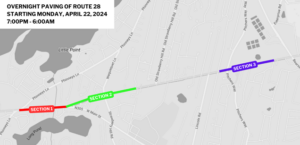 HYANNIS – Some of us are “white knuckle flyers” from the anxiety of traveling on a plane, while others experience much of the same apprehension at the thought of going to see their primary care provider or a specialist.
HYANNIS – Some of us are “white knuckle flyers” from the anxiety of traveling on a plane, while others experience much of the same apprehension at the thought of going to see their primary care provider or a specialist.
Both situations can be enough to raise your blood pressure and, in the case of a medical appointment, it’s known as “white coat syndrome” or “white coat hypertension.”
The term gets its name from the white coat physicians have worn as a symbol of medicine and medical authority for more than 100 years, according to an article on the American Medical Association Journal of Ethics.
“But it (the white coat) has also grown to be so intimidating to some patients that pediatricians and psychiatrists generally choose not to wear it in order to reduce anxiety on the part of their patients,” said Mark S. Hochberg, MD, a contributor to the AMA website.
While white coat hypertension has been the subject of many studies over the years to determine if it is harmless or something to be concerned about, a recent study of almost 64,000 people in Spain published in the New England Journal of Medicine concluded that white coat hypertension can be a problem for patients and further assessment is needed as an outpatient to determine if their blood pressure is high at other times, not just when they are under stress.
“In the last few observational studies, they thought if the blood pressure was high in the clinic, and you re-checked it, if it was lower than the initial one, it wasn’t a big issue,” said John Guerin, MD, FACC, a Falmouth Hospital cardiologist.
“The way I looked at it, even before the study came out, if a patient came in to the office saying they have white coat hypertension, and their blood pressure is 140-150 for the systolic (upper reading), just a little bit out of range, and it’s lower when we check it a second time, then we’ll want them to watch it as an outpatient [at home] and check it a few times to make sure that’s the case.
“If they come into the office and they’re systolic reading is 180-190, even if they have white coat hypertension, it’s probably high normal or borderline high as an outpatient and you don’t want someone to have blood pressure that high, even if it’s just under stressful conditions.”
Another concern is white coat hypertension can be an indicator for “masked hypertension,” when your blood pressure is normal in a clinic or physician’s office and high as an outpatient, when not under stress.
“We’ve had a few patients, and they are rare, who will have low blood pressures in the office and are high elsewhere or when they check it at home,” said Dr. Guerin.
In both situations, he recommends patients take their blood pressures at home and keep a journal.
“We have them bring their blood pressure monitor into the office so we can watch them check their blood pressure and then we check it with ours, which we know is accurate, to make sure they are getting a correct reading,” he said. “We want to make sure we are dealing with apples to apples, not apples to oranges.”
Normal Blood Pressures
Recommendations for a normal blood pressure range keep changing, said Dr. Guerin.
“Now the recommendation is more towards 130 over 80, as more ideal as an outpatient. When you’re in a clinic, the recommendation is 140 over 90. Generally, we want the systolic below 140 and the diastolic (lower reading) below 90, and a bit lower readings for diabetics.”
Tips for Accurate Blood Pressure Monitoring
Dr. Guerin and the American Heart Association recommend the following when taking your blood pressure at home:
Use a blood pressure monitor made for your upper arm, not your wrist.
Use a blood pressure monitor that doesn’t require a stethoscope.
Ensure at least five minutes of quiet rest before taking your blood pressure and don’t drink caffeinated drinks for up to one-half hour before you take it.
Sit with your back straight, feet flat on the floor and place your arm on a flat surface and position the blood pressure monitor above your elbow.
Measure your blood pressure at the same time every day.
Don’t put the monitor over your clothes.
Dr. Guerin stressed the importance of monitoring blood pressure at home before making decisions about treatment.
“We have to be careful not to react to one or two high readings in the office,” he said. “Once we have several readings, then we can make an informed decision about medication.”
























